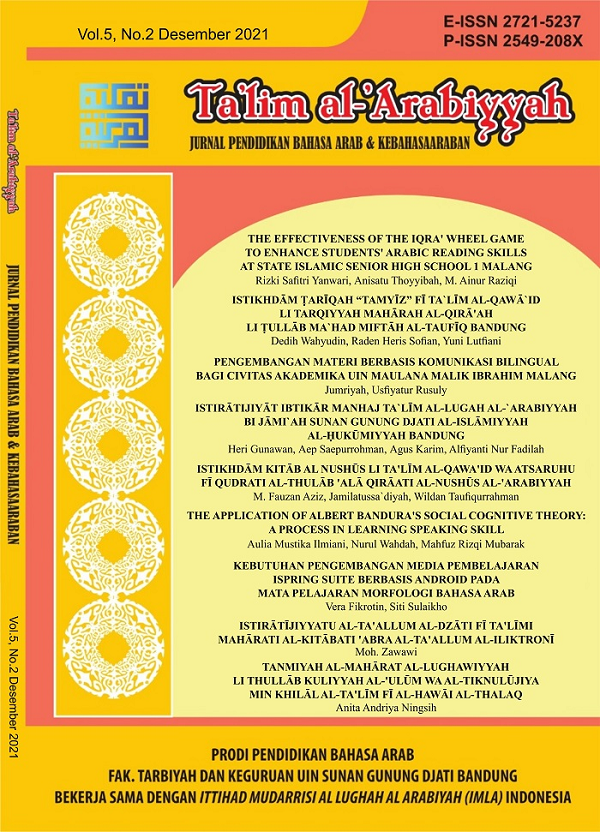Kebutuhan Pengembangan Media Pembelajaran iSpring Suite Berbasis Android Pada Mata Pelajaran Morfologi Bahasa Arab
DOI:
https://doi.org/10.15575/jpba.v5i2.13587Abstract
Learning media is an important component so that the process of teaching and learning activities in class is carried out properly. Learning media as a means or intermediary tool in order to convey messages in the form of learning. This study aims to determine the needs of students in learning media Shorof. Where the effective media is the media according to the needs of students. The researcher uses the R&D method with a 4D Thiagarajan model in this study which consists of defining, planning, developing and disseminating. In collecting data, the researchers conducted observations and gave questionnaires to students' media needs. The average results show that students need learning media that can be accessed at any time to increase enthusiasm for learning in class VIII A with a percentage value of 79.00% (Required) and class VIII B with a percentage value of 83.00% (Required). The results of the percentage value state that students need an Android-based ispring suite learning media on shorof subjects because it can be accessed anytime.
References
Binti Jasni, N. S., & Ardiansyah, A. A. (2020). Arabic Learning Based On E-Learning Using Arabic Teacher Website In The Pandemic Era Of Covid-19. Ta’lim al-’Arabiyyah: Jurnal Pendidikan Bahasa Arab & Kebahasaaraban, 4(2), 122–137. https://doi.org/10.15575/jpba.v4i2.8601
Budiyono. (2020). Inovasi Pemanfaatan Teknologi Sebagai Media Pembelajaran Di Era Revolusi 4.0. Jurnal Kependidikan, 6(2), 300–309.
Falahudin, I. (2014). Pemanfaatan Media Dalam Pembelajaran. Jurnal Lingkar Widyaiswara, 1(Desember), 104–117.
Mahnun, O. N. (2012). MEDIA PEMBELAJARAN ( Kajian terhadap Langkah-langkah Pemilihan Media dan Implementasinya dalam Pembelajaran ). Jurnal Pemikiran Islam, 37(1), 27–33.
Naseha, S. D., & Muassomah, M. (2018). Model Pembelajaran Ilmu Sharaf Dengan Menggunakan Metode Inquiry Dan Metode Tashrif (di Jurusan Pendidikan Bahasa Arab UIN Maulana Malik Ibrahim Malang). Alfazuna, 3(Juni), 103–122.
Nurrita, T. (2018). Pengembangan Media Pembelajaran Untuk Meningkatkan Hasil Belajar Siswa. Misykat, 03(Juni), 171–187.
Purnama, S. (2013). Produk Pembelajaran Bahasa Arab. Literasi, 4(1), 19–32.
Ramadani, E. M. (2020). Media Pembelajaran Berbasis Aplikasi Android Menggunakan PowerPoint Ispring Suite 9 dengan Model POE2WE pada Materi Teori Kinetik Gas : Literature Review. Jurnal Pendidikan Fisika Tadolako Online (JPFT), 8(3), 79–86.
Sugiyono. (2019). Metode Penelitian Kuantitatif, Kualitatif dan R&D.
Sulaikho, S. (2021). Analisis Ilmu Shorof.
Additional Files
Published
How to Cite
Issue
Section
License
Authors who publish in Ta'lim al-'Arabiyyah: Jurnal Pendidikan Bahasa Arab dan Kebahasaaraban agree to the following terms:
- Authors retain copyright and grant the journal right of first publication with the work simultaneously licensed under a Creative Commons Attribution-ShareAlike 4.0 International (CC BY-SA 4.0) License that allows others to share the work with an acknowledgment of the work's authorship and initial publication in this journal.
- Authors are able to enter into separate, additional contractual arrangements for the non-exclusive distribution of the journal's published version of the work (e.g., post it to an institutional repository or publish it in a book), with an acknowledgment of its initial publication in this journal.
- Authors are permitted and encouraged to post their work online (e.g., in institutional repositories or on their website) prior to and during the submission process, as it can lead to productive exchanges, as well as earlier and greater citation of published work (See The Effect of Open Access).
![]()
Ta'lim al-'Arabiyyah: Jurnal Pendidikan Bahasa Arab dan Kebahasaaraban is licensed under a Creative Commons Attribution-ShareAlike 4.0 International License.
Based on a work at https://journal.uinsgd.ac.id/index.php/Talim







